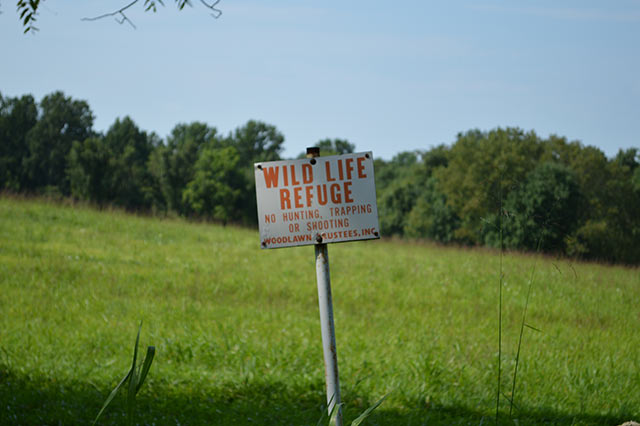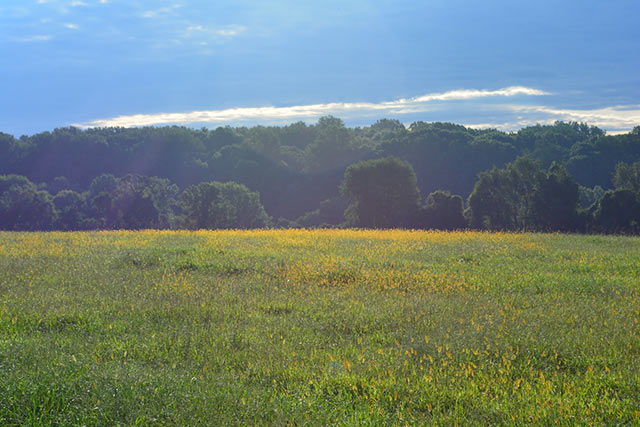
In an elaborate bait-and-switch maneuver, a “not for profit” organization controlling 800 acres of wildlife refuge surrounding Delaware’s only national park reneged on its original conservation mission by selling a large tract to for-profit developers, one of whom sits on one of the organization’s board of directors.
The Woodlawn Trustees, as they’re known, have set up a few insiders to cash in on land that was financed in large part by taxpayers over many decades. These insiders also happen to be major campaign donors to more than a dozen Delaware and Pennsylvania elected officials who could block the privatization of these de facto public lands.
Knowing this sacrilege would incite outrage in the Brandywine Valley, the Woodlawn Trustees launched a public relations campaign that inadvertently exposed their true nature.
Delaware’s First National Park
Until 2013, Delaware was the only state without a “unit” of the National Park Service, an embarrassing distinction considering that 408 units of the National Park Service dot the map of the United States. This fact, coupled with the paucity of wildlife refuges (just two of the 560 national wildlife refuges), motivated some state and federal officials to secure a national park for the “first state.” It finally joined the club when President Obama created the First State National Monument on March 25, 2013, with Congress designating it the First State National Historical Park a year later.
But the First State National Historical Park came up very short of what it could have been compared to other national parks. A patchwork of noncontiguous historical sites scattered across Delaware, it had only one expanse of open land: a gerrymandered 1,100 acres carved out of an existing 1,900-acre, taxpayer-subsidized public wildlife refuge in northern Delaware and Chadds Ford, Pennsylvania. Soon after the Mount Cuba Center (a Delaware nonprofit focused on native plant education and natural habitat conservation) contributed the $21 million to purchase the 1,100 acres, the owner of the remaining 800 acres surrounding the park moved to spoil the boundary with commercial and residential developments that a few well-connected insiders would cash in on. This elaborate bait-and-switch triggered an epic preservation fight in the Brandywine Valley and exposed the contempt that local, state and federal officials have for taxpayers.
 The Woodlawn Trustees held onto 800 acres of the flattest, most developable land thus gerrymandering the boundary of the First State National Historical Park. (Graphic: Jason Hoover)
The Woodlawn Trustees held onto 800 acres of the flattest, most developable land thus gerrymandering the boundary of the First State National Historical Park. (Graphic: Jason Hoover)
Tax Breaks for Trails
The threatened 800 historic acres sitting on the Pennsylvania-Delaware border are part of what’s known locally as “Beaver Valley” and are just a cannon shot from Brandywine Battlefield and the iconic Chadds Ford countryside that Andrew Wyeth spent a lifetime capturing in paint. No one would have ever thought this land could be developed, considering it had been owned for many decades by an ostensible land preservation organization with Quaker beginnings, the Woodlawn Trustees. For more than 40 years, all of their land in Beaver Valley has been a publicly accessible wildlife refuge.
In the 1960s, having acquired most of the land they would come to own, the Woodlawn Trustees fought a legal battle with the IRS over their 501(c)(3) designation. Woodlawn’s attorneys vanquished the IRS, but the trustees nevertheless decided to shed their tax-exempt status and become a “not for profit” but tax-paying corporation. Facing large tax bills for the first time on their thousands of acres, the trustees quickly enrolled their holdings in two state conservation programs – Act 319 in Pennsylvania and the Agricultural Preservation Program in Delaware. While these programs provided them with massive tax breaks, there were conditions attached.
Woodlawn could have approached conservation groups that would have paid the same wholesale price as any developer.
Both programs mandated that the public be allowed to reasonably use any land receiving “preservation” tax subsidies. Before this, Woodlawn employed security guards to chase people off the land, so it was probably with reluctance that they “invited” the public to ramble through their new “wildlife refuge” in Beaver Valley with its old forests and undulating meadows. The public’s access to this new vast trail system had conditions, too. For 40 years, they paid larger tax bills to cover Woodlawn’s subsidy.
Woodlawn would say that they have to pay “roll back taxes,” but these only go back 10 years in Delaware and just seven years in Pennsylvania. They would pay no other penalty in either state, despite reaping the benefits of the programs for 40-plus years. A pledge by Pennsylvania State Rep. Stephen Barrar to introduce legislation stiffening the penalty for withdrawing from Act 319 never materialized, so the affront to taxpayers remains.
When one law’s weakness failed the taxpayer, the Pennsylvania Constitution should have come to the rescue. After Woodlawn proposed developing 324 acres in 2012, protective action should have been taken immediately by officials at every level. The longtime use of taxpayer money to finance the land’s purchase and ownership made Beaver Valley a public resource and taxpayers part owners. Any attempt to take it for private profit should have automatically invoked the Pennsylvania Constitution’s environmental rights amendment:
The people have a right to clean air, pure water, and to the preservation of the natural, scenic, historic and esthetic values of the environment. Pennsylvania’s public natural resources are the common property of all the people, including generations yet to come. As trustee of these resources, the Commonwealth shall conserve and maintain them for the benefit of all the people.
To head off criticism, Woodlawn manufactured a creation myth of the national park by claiming they donated the land. Woodlawn spokesman Vernon Green continues to repeat this inanity, saying that Woodlawn “transferred over” the land. Their website still suggests this, too. The truth is that they created a shell 501(c)(3) affiliate called “Rockford Woodlawn” (same phone number and address as Woodlawn) to which they passed ownership of the 1,100 acres. So when the Mount Cuba Center deposited $21 million dollars into a Rockford Woodlawn bank account, Woodlawn paid no taxes.
 A spectacular but threatened view of Beaver Valley. (Photo: Maria Cavanaugh)
A spectacular but threatened view of Beaver Valley. (Photo: Maria Cavanaugh)
Betraying Two Legacies
The “Woodlawn Wildlife Refuge” was the fulfillment of one man’s dream. Around 1900, William Bancroft, a Quaker mill owner in Wilmington, Delaware, saw his city rapidly spilling into the countryside and decided to spend his fortune protecting open land for future generations. He created the Woodlawn Trustees to further this mission. Subsequently, at a time when corporate tax rates ran as high as 52 percent, the trustees’ tax-exempt status gave them more money to buy up land in Beaver Valley.
Bancroft also charged the trustees with looking after hundreds of working-class homes in Wilmington he had built. These “Flats,” as they’re known, were not just to provide affordable housing. They were to be a source of revenue to be used for the purchase of additional land. However, not only are rents no longer used to buy land, but Woodlawn now claims that the roughly $4 million in rent from their nearly 500 housing units in the Wilmington area are not enough to maintain their rentals: They claim now that they need to sell land to maintain their rentals.
This dubious rejiggering of Bancroft’s original mission requires that the public not know about the extent of their massive tax subsidies or their substantial rent income. Also important for this new story to gain traction is the idea that Woodlawn could only sell to developers. Yet Woodlawn could actually have approached conservation groups that would have paid the same wholesale price as any developer. In fact, Woodlawn’s Vernon Green even admitted that it doesn’t matter to them who buys their land, an astounding revelation by the spokesman of an organization with a much-publicized conservation mission.
That Woodlawn never approached conservation groups might have had something to do with one of the developers. Richard Julian, owner of Eastern States Development and a major political campaign donor, sits on the board of a Woodlawn affiliate called the Todmorden Foundation (same address and phone number as Woodlawn and Rockford Woodlawn). His board seat positioned him to cash in on Bancroft’s legacy, and his campaign donations ensured a free hand.
No part of this travesty would impugn Woodlawn’s motives more than the facts surrounding the purchase of 51 acres from a Dr. Merlin Brubaker in 1981. In 1939, he and his wife Clara purchased a dairy farm eight miles north of DuPont at 123 Beaver Valley Road. He drew up a detailed map that laid out his vision for an arboretum, and over the next decades, Merlin and Clara Brubaker worked tirelessly to transform a tired landscape into an orchard of various fruit trees, rare exotic specimen trees and dozens of one-of-a-kind tree varieties he created using his expert grafting skills.
From the 1960s to 1980, Brubaker was contacted repeatedly by developers wanting to subdivide the estate, but letting the arboretum get carved up was absolutely out of the question. As he neared his 70s, he began to plan for its permanent protection and contacted Woodlawn to see if they would add his land to their wildlife refuge. The Woodlawn Trustees agreed, and in 1981 they purchased and vowed to conserve the land, a promise captured in a letter from Woodlawn president Stephen Clark to Brubaker. Clark thanked Brubaker for allowing them to add “his tract of land to that which Woodlawn tries to protect.” Unfortunately, Woodlawn never placed any conservation easement on Brubaker’s land, which would have legally protected it. Some 30 years later, Woodlawn wasn’t hiding their betrayal of Brubaker when they listed “123 Beaver Valley Road” as the address for the “Vineyard Commons” development plan.
 Sunset in Beaver Valley. (Photo: Greg Young)
Sunset in Beaver Valley. (Photo: Greg Young)
Protecting Campaign Donors, Not Open Space
Part of Beaver Valley lies in Concord Township, Pennsylvania, and the supervisors there – who were presented with development plans in 2012 – said that they were caught off guard by Woodlawn. Yet Vernon Green had made a presentation to the supervisors in June 2011 about Woodlawn’s intention to develop Beaver Valley. In the year that followed, they took no proactive steps to find a conservation solution for the land despite touting this open space as a township amenity, having an “open space committee” and having substantial funds available from a previous bond issue to defray the cost of any preservation effort.
Not too long after Green’s 2011 visit, individual Woodlawn board members and officers began making interstate campaign contributions to the supervisors’ re-election committees. Green, developers, board member Richard Julian and others all gave generously. Then the supervisors began making pro-Woodlawn statements and misrepresenting what the opposition was proposing. One of the more ironic comments came from supervisor Dominic Pileggi, who said the protesters “mean well, but don’t understand the issues,” a statement that completely ignored the special subsidized nature of the wildlife refuge, the former nonprofit status of Woodlawn, the agreements Woodlawn made with various landowners to protect land and the public’s unfettered use of the land for more than 40 years.
Elected officials in Delaware – local, county, state and federal – did their part to help Woodlawn by maintaining a radio silence worthy of maritime warfare. Woodlawn board members Richard Julian and Robert Harra donated to the campaigns of almost every county, state and federal official having the power to stop the development. Julian has given copiously to Rep. John Carney, Senators Chris Coons and Tom Carper, former Delaware Gov. Mike Castle, current Delaware Gov. Jack Markell, State Sen. Greg Lavelle, and New Castle County officials Bob Weiner and Tom Gordon. Almost every single person in Delaware at the county, state and federal level whose district encompasses Beaver Valley have been recipients of Julian’s largesse.
Robert Harra is the former president of Wilmington Trust and currently under federal indictment for allegedly hiding losses and negligently bankrupting a Delaware banking institution founded by members of the DuPont family. His substantial donations went to Delaware State Rep. Deborah Hudson with other state and federal Republican officials indirectly benefitting from political action committees he supported. On the Pennsylvania side, developer Frank McKee fattened Sen. Pat Toomey and Rep. Pat Meehan’s campaign coffers. Pennoni Associates, an engineering firm with skin in this game, gave to Sen. Robert Casey. And this is by no means an exhaustive accounting of campaign donations to officials who could have used their offices to protect the wildlife refuge.
Many officials in both states were repeatedly asked to publicly oppose the plans to no avail – that is, until three hours before a critical supervisors’ meeting on March 18, 2015, which would determine the fate of Beaver Valley. An open letter from Senators Carper and Coons and Representative Carney was released just before the meeting suggesting that a “cooling off period” be observed and that a conservation solution be explored for Beaver Valley.
The opposition was grateful, but this was a case of too little too late. The last-minute timing suggested they were appeasing the public while avoiding giving offense to campaign donors like Richard Julian. Nevertheless, the letter was lost on the Concord supervisors who ignored their constituents’ concerns, The Brandywine Conservancy and PennFuture’s criticisms and dozens of violations of their own development code by approving the preliminary plans for the “Vineyard Commons” development in Beaver Valley.
The massive opposition to the development plans had coalesced by this point into three groups: the Beaver Valley Conservancy, Save the Valley and the Beaver Valley Preservation Alliance. The latter two groups have focused on educating and keeping the public informed while the Beaver Valley Conservancy assembled and funded a dream team of experts who compiled a record of 52 separate Concord Township development and building code violations with regard to the “Vineyard Commons” development plans.
The supervisors barely acknowledged this evidence when they approved the preliminary plans, explaining before their vote that they “had confidence in their own experts.” Yet almost every single person sitting on the developer’s side of the table – lawyers, civil engineers, planners, architects, Woodlawn employees and the developers themselves – was a campaign donor to the Concord political machine, which would allow them to profit from spoiling the boundary of Delaware’s only national park.
The fight to save Beaver Valley has now moved to the courts, and in the meantime, Woodlawn continues to ignore public opposition to their ongoing plans to develop their subsidized land. They have recently proposed developing another 42 acres on the Delaware boundary of the First State National Historical Park, the first phase of which would be a campus for Wilmington University, which ranks near the bottom nationally in many criteria. In exchange for a second-rate commuter college with a 99.9 percent acceptance rate but only a 38 percent graduation rate, the public would get another spoiled park gateway, lost trails, decades of lost tax revenue and impaired streams that drain to the Brandywine Creek, the source of Wilmington’s tap water.
Our national parks are sacred places that face constant aesthetic and existential threats. Efforts to desecrate other park boundaries have been thwarted before, so the threat to the First State National Historical Park is not unstoppable. But this will require officials in Delaware and Pennsylvania to live up to the oaths they took and to start looking after the interests of their constituents – instead of their campaign donors.
UPDATE:
In the discussion of politicians who’ve received campaign donations from the would-be developers of Beaver Valley, one was inadvertently left off the list. Pennsylvania State Senator Dominic Pileggi, cousin of the Concord Township supervisor, received at least $4,500 from Frank McKee and thousands more from another developer eyeing Beaver Valley: Steven Wolfson. To date, Pileggi has not spoken out against the plans to spoil the boundary of the First State National Historical Park and taxpayer-subsidized wildlife refuge in his district.
The lawsuit filed by the Beaver Valley Conservancy deals with the preliminary approval of the “Vineyard Commons” plans by the Concord supervisors. These plans were concerned with approximately 225 acres in the Concord Township portion of Beaver Valley. The other 575 acres surrounding the First State National Historical Park have no associated plans finalized or approved in Delaware or Pennsylvania.
Join us in defending the truth before it’s too late
The future of independent journalism is uncertain, and the consequences of losing it are too grave to ignore. To ensure Truthout remains safe, strong, and free, we need to raise $46,000 in the next 7 days. Every dollar raised goes directly toward the costs of producing news you can trust.
Please give what you can — because by supporting us with a tax-deductible donation, you’re not just preserving a source of news, you’re helping to safeguard what’s left of our democracy.